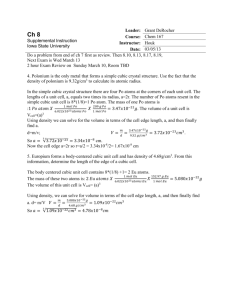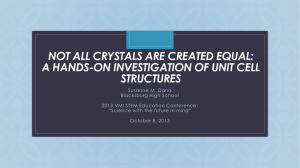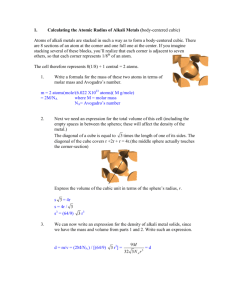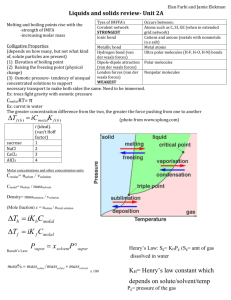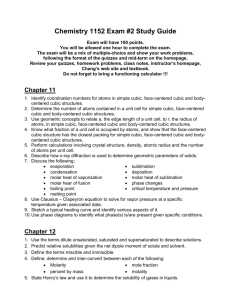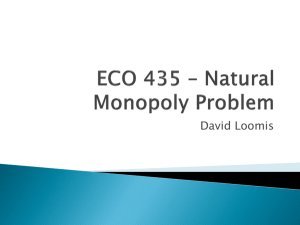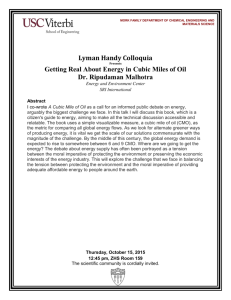11.7 Structures of Solids
advertisement
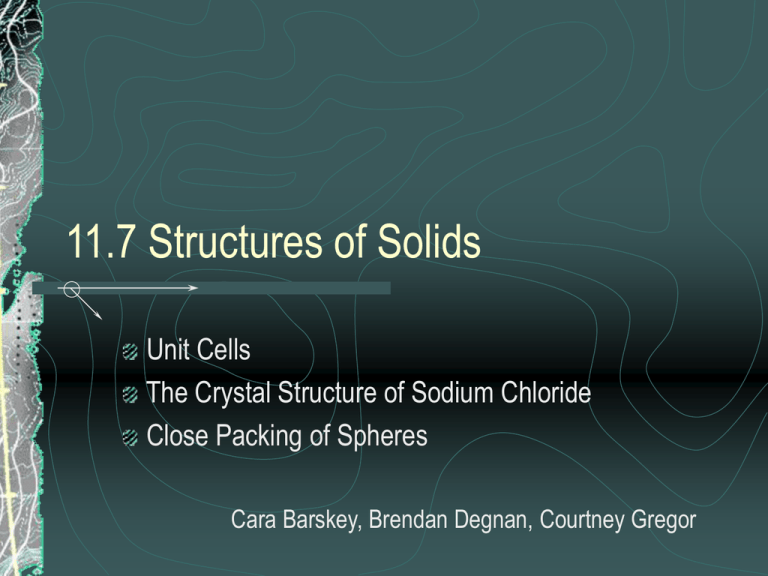
11.7 Structures of Solids Unit Cells The Crystal Structure of Sodium Chloride Close Packing of Spheres Cara Barskey, Brendan Degnan, Courtney Gregor Crystalline Solids Atoms, ions, or molecules are ordered in welldefined arrangements Amorphous Solids Greek – “without form”, particles have no orderly structure Quartz When melted, converted from crystalline amorphous Unit Cell Repeating unit of a solid, the crystalline “brick” Shows symmetry characteristic of entire pattern (2dimensional) Described by lengths of edges and angles Crystal lattice - represented by 3-D array of points Types of Unit Cells 7 basic types - simplest is cubic unit cell 3 types of cubic unit cell Primitive: lattice points at CORNERS ONLY Body-centered: at corners and at center of unit cell Face-centered: lattice points at corners and at center of each face Simple crystal structures Cubic unit cells with only ONE ATOM centered at each lattice point – as seen in metals 3-D Solids Nickel atom on each of the eight corners of the cell Simple cubic structure: 8 corners x 1/8 = 1 atom Body-centered cubic structure = two atoms per unit cell Body-centered cubic structure: (8 corners x 1/8) + 1 body = 2 atoms Six atoms on the faces of the unit cell = three nickel atoms, for a total of four atoms per unit cell Face-centered cubic structure: (8 corners x 1/8) + (6 faces x 1/2) = 4 atoms Crystal Structure of Sodium Chloride Particles at corners, edges, and faces are shared by other unit cells (fractions) Total cation : anion ratio must be SAME for entire crystal Equal number of Na+ ions and Cl- ions Ex: Unit cell of CaCl2 1 Ca+2 for every 2 Cl- Fraction of an atom that occupies a unit cell Position in Unit Cell Center Fraction in Unit Cell 1 Face 1/2 Edge 1/4 Corner 1/8 Practice Plan : Find total number of ions of each type Solve : There is 1/4 of an Na+ on each edge, a whole Na+ in the center, 1/8 of a Cl- on each corner, and 1/2 of a Cl- on each face. Close Packing of Spheres Close contact, maximize forces Most efficient arrangement equal-sized spheres Each sphere has six others in layer Possible to have second and third layer Two Depression Types of rd 3 Layer Hexagonal Close Packing 3rd layer spheres are placed in line with 1st layer 1,3 & 2,4 repeat = ABAB Cubic Close Packing 3rd layer spheres are placed as staggered in relation to 1st layer 1,4 repeat = ABCA Face-centered cubic Coordination Number Each sphere 12 equidistant neighbors Coordination number = 12 Number of particles immediately surrounding a particle in the crystal structure Body-centered has coordination number of 8 Simple cubic-centered has coordination number of 6 Unequal-sized spheres: large particles take closepacked arrangements, small particles occupy cavities between larger spheres Section Questions How does an amorphous solid differ from a crystalline one? Give an example of an amorphous solid In a crystalline solid, particles are arranged in a regularly repeating pattern. An amorphous solid is one whose particles show no such order. An example of an amorphous solid is rubber or glass. Amorphous silica has a density of about 2.2 g/cm3, whereas the density of crystalline quartz is 2.65 g/cm3. Account for this difference in densities Something has an effect on something that causes one thing to be more dense than the other thing What is a unit cell? What properties does it have? The unit cell is the smallest part of the crystal than can reproduce the three-dimensional structure, which can also be represented by its crystal lattice. The simplest unit cells are cubic; these cubic unit cells can be primitive, body-centered, or facecentered. Perovskite, a mineral composed of Ca, O, and Ti has the cubic unit cell shown in the drawing. What is the chemical formula of this mineral? TiCa8O6 The elements xenon and gold both have solid-state structures consisting of cubic close-packed arrangements of atoms. Yet Xe melts at -112 °C and gold melts at 1064 °C. Account for these greatly different melting points. It requires more kinetic energy to overcome the delocalized metallic bonding in gold than to overcome the relatively weak London dispersion forces in xenon. Rutile is a mineral compound of Ti and O. It’s unit cell, shown in the drawing, contains Ti atoms at each corner and a Ti atom at the center of the cell. Four O atoms are on the opposite face of the cell, and two are entirely with-in the cell. A.) What is the chemical formula. B.) What is the nature of the bonding that holds the solid together? Ti3O2 Electrostatic attractions because its ionic bonding (see Table 11.7 on page 435) Iridium crystallizes in a face-centered cubic unit cell that has an edge length of 3.833 Angstroms. The atom in the center of the face is in contact with the corner atoms, as shown in the drawing. A.) Calculate the atomic radius of an iridium atom. B.) Calculate the density of the iridium metal. 4(192.2 amu)=768.8 amu 768.8 amu (3.833 Å)3 22.7 g/cm3 1g 6.02 x 1023 amu (1 Å)3 (10^-8 cm)3 Aluminum metal crystallizes in a cubic close-packed structure (face-centered cubic cell, Figure 11.34). A.) How many aluminum atoms are in a unit cell? B.) What is the coordination number of each aluminum atom? C.) Assume that the aluminum atoms can be represented as spheres, as shown in the drawing fro Exercise 11.59. If each Al atom has a radius of 1.43 Å, what is the length of a side of the unit cell? D.) Calculate the density of aluminum metal. ½(6)+1/8(8)=4 atoms of Al 12, it’s a face-centered cubic cell unit 1.43 Å x 4=5.72 Å 2x2=5.72 4(27.0) amu 1g (1 Å)3 x=1.69 Å (1.69 Å)3 6.02x1023 amu (10^-8 cm)3 37.2 g/cm3
